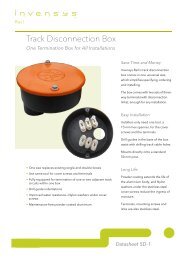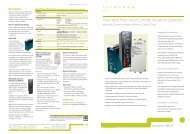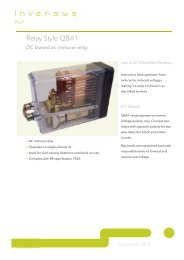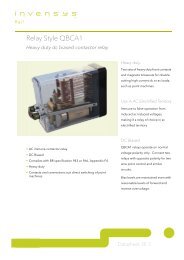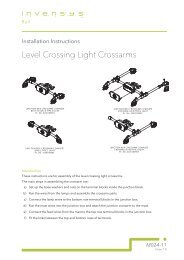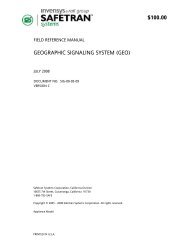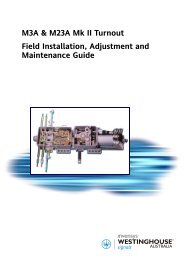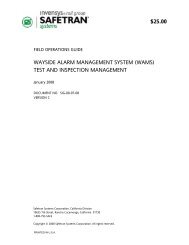Total Cost of Ownership of Rail Signalling Systems ... - Invensys Rail
Total Cost of Ownership of Rail Signalling Systems ... - Invensys Rail
Total Cost of Ownership of Rail Signalling Systems ... - Invensys Rail
You also want an ePaper? Increase the reach of your titles
YUMPU automatically turns print PDFs into web optimized ePapers that Google loves.
<strong>Total</strong> <strong>Cost</strong> <strong>of</strong> <strong>Ownership</strong> <strong>of</strong> <strong>Rail</strong> <strong>Signalling</strong> <strong>Systems</strong> <strong>Total</strong> <strong>Cost</strong> <strong>of</strong> <strong>Ownership</strong> <strong>of</strong> <strong>Rail</strong> <strong>Signalling</strong> <strong>Systems</strong><br />
16<br />
Finding 3:<br />
Technology use and engineer<br />
motivation markedly improves<br />
failure rates<br />
Once the signalling system<br />
is in place, the focus switches<br />
to performance. Performance<br />
is a measure <strong>of</strong> reliability<br />
and delays to passenger<br />
journeys. Three out <strong>of</strong> four<br />
<strong>of</strong> the operators in this study<br />
describe themselves as capacity<br />
constrained particularly during<br />
peak hours <strong>of</strong> commuter<br />
traffi c. Delays caused during<br />
these periods have far<br />
reaching consequences.<br />
“ Between 2003/04<br />
and 2006/07 there<br />
was a 44% reduction in<br />
the number <strong>of</strong> failures<br />
across the network.”<br />
The cost <strong>of</strong> delays<br />
The cost <strong>of</strong> delays is threefold:<br />
1 Bad press is never a good thing in rail; with<br />
a public image to protect and a passenger<br />
charter to uphold, most operators prefer to<br />
remain out <strong>of</strong> the newspaper headlines and away<br />
from political scrutiny<br />
2 Revenue deterioration is a real consequence if<br />
customers have alternative modes <strong>of</strong> transport<br />
they can resort to rather than rail. There is<br />
evidence to suggest that passengers value<br />
certainty <strong>of</strong> journey time over the actual journey<br />
time – the message is deliver on your promise<br />
3 Financial penalties. At some operators there<br />
is a real fi nancial cost associated with delays<br />
which can be as much as US $80 per minute <strong>of</strong><br />
delay. These are effectively penalty charges that<br />
are levied by the train operator or regulator for<br />
delays caused by infrastructure performance.<br />
Penalty regimes are not commonplace and<br />
some would argue that penalties are perverse<br />
instruments as they reduce the money available<br />
for maintenance and renewals work. A further<br />
cost, though not explicitly measured, is the<br />
increased burden <strong>of</strong> reactive maintenance –<br />
more delays, more callouts, more engineers<br />
required, more cost<br />
Reducing delays<br />
through motivation<br />
Operator B performs their maintenance activity<br />
in-house and for many years performance had<br />
languished. A performance management expert<br />
was hired from outside the rail industry and<br />
one <strong>of</strong> the fi rst things that he did was begin<br />
measuring performance at a more detailed level.<br />
Realising that accountability for performance<br />
lay in the hands <strong>of</strong> the maintenance managers<br />
and their crews, he began disseminating this<br />
information downwards rather than just upwards<br />
Figure 10: Reduction in signal failures after introducing motivational measures<br />
2003/4 2004/5 2005/6 2006/7<br />
to senior management. Crucially, he gathered<br />
data by maintenance crews (responsible for a<br />
particular region) and published the results to<br />
compare performance by region.<br />
The effect was startling, between 2003/04 and<br />
2006/07 there was a 44% reduction in the number<br />
<strong>of</strong> failures across the network, refer to Figure 11.<br />
The reduction was attributable to competition<br />
between crews keen to better than their peers,<br />
changing behaviours is a powerful force.<br />
I300203_<strong>Invensys</strong>_<strong>Cost</strong>Of<strong>Ownership</strong>_WhitePaper.indd 16-17 13/04/2010 15:11<br />
Number <strong>of</strong> annual failures<br />
3500<br />
3000<br />
2500<br />
2000<br />
1500<br />
1000<br />
500<br />
0<br />
Source: Operator B<br />
44%<br />
<strong>Signalling</strong><br />
Points<br />
Track circuits<br />
17





